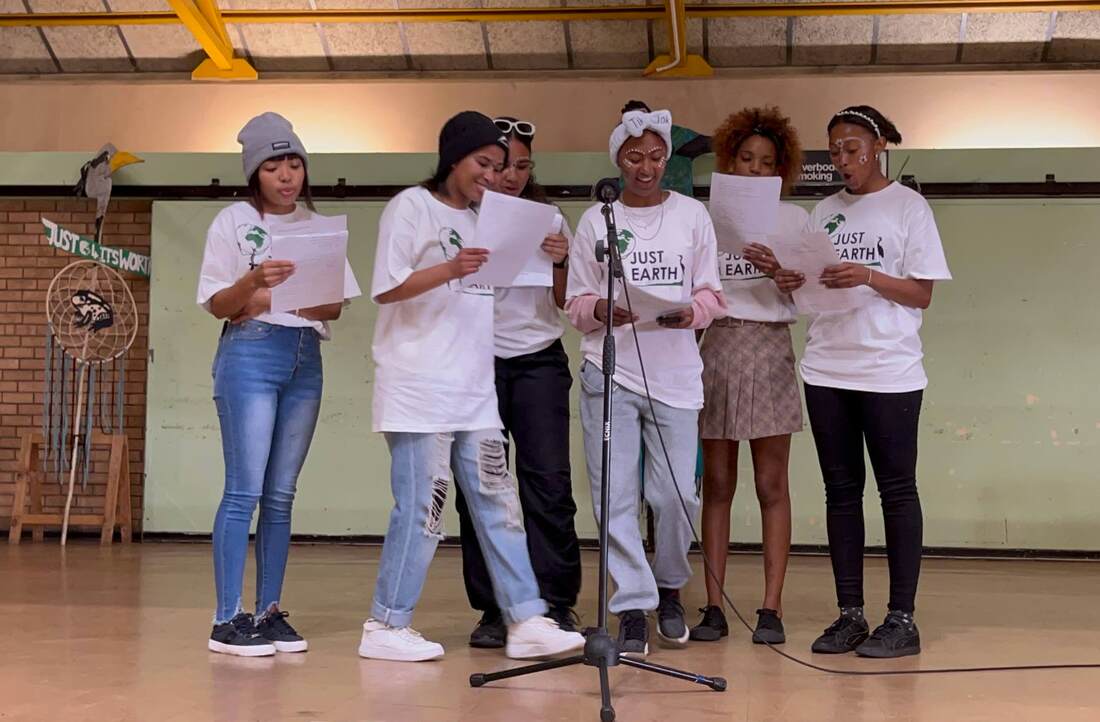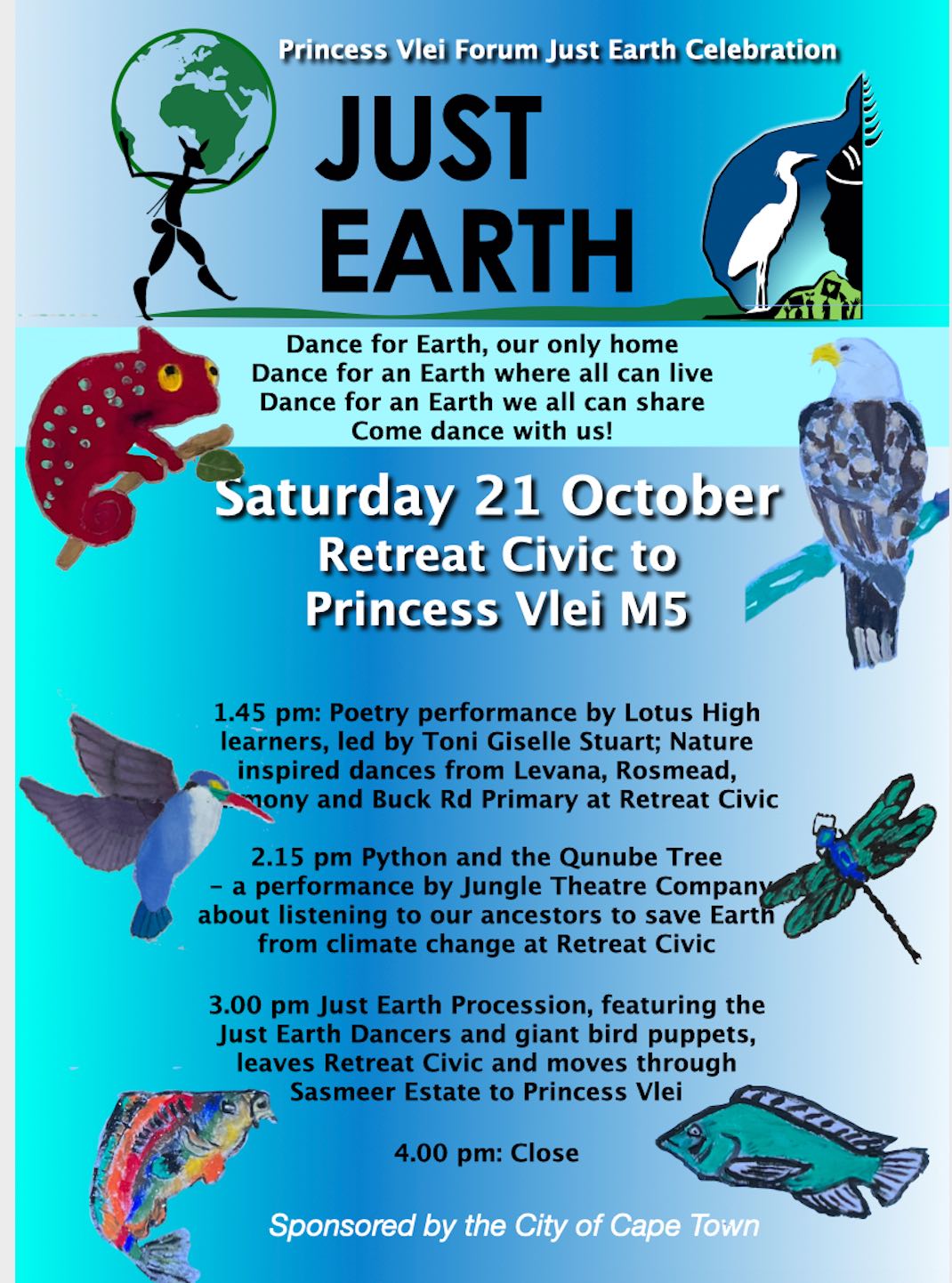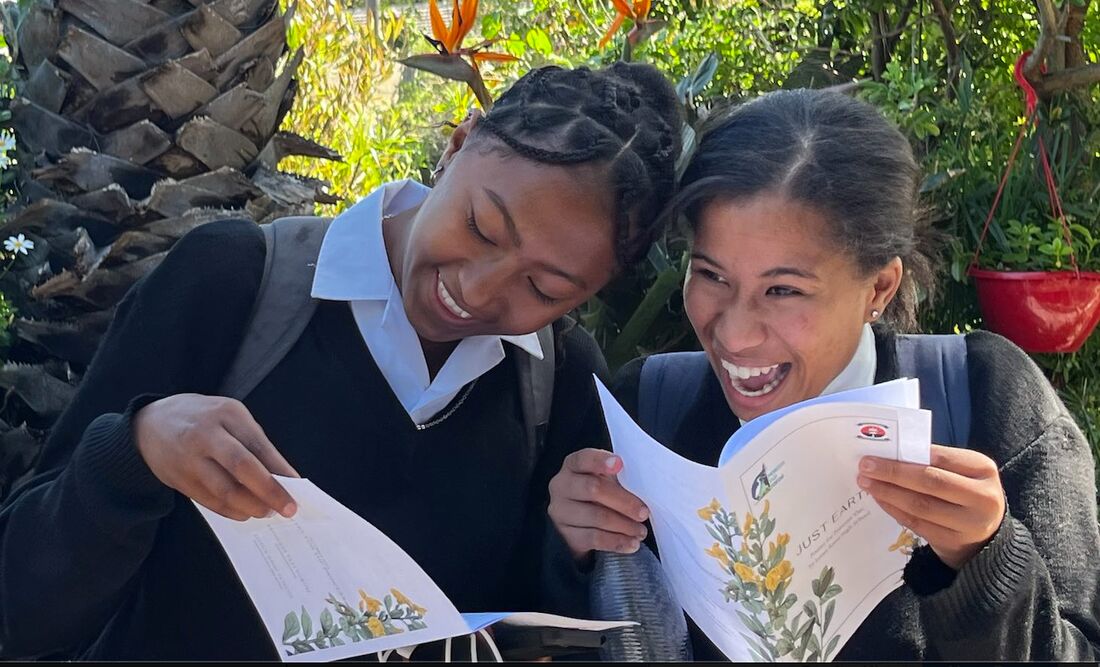|
Princess Vlei, Cape Town Photographs provided by Leila Matrani. Written by Simon Tamblyn. What a great turnout! Eighteen excited people pitched up early on a Saturday morning for Princess Vlei Forum’s City Nature Challenge walk for 2024. We met outside the car park of the Eco Park facilities and were greeted with a sunny, not too cold and windless autumn day, giving us perfect conditions to explore the dunes between the Little Princess and the “big” Princess, just outside the Eco Park facilities. If you are not familiar with the City Nature Challenge, here’s the quick explanation. It’s an annual global (friendly) citizen science competition between cities, countries and individuals to rack up as many ‘observations’ of wild organisms on the iNaturalist app in urban and peri-urban areas. Read more about it here: https://www.citynaturechallenge.org/. It is a perfect blend of technology, fun, science education (especially for youngsters), socialising and light exercise The conservation angle is also hugely important, especially for fynbos. Humans have evolved alongside trillions of other organisms, many of them are so commonplace, that they are near invisible. Many species here on the southern tip of Africa have evolved so close to humanity, that they can almost entirely escape our senses, even when they’re right in front of us. And when we can not even accurately describe where we might find some species - especially if they are threatened with extinction - it becomes difficult for us to protect them from us.
This is the greater purpose of the City Nature Challenge, by enjoying an exciting day out with like-minded individuals we focus on observing the life that we typically don’t give time to observe on a daily basis. This data - if it is good quality and with the user’s permission - will be used by conservationists, ecologists and others to further efforts in maintaining the health of our natural areas across the planet. We photographed as many wild organisms as we could. All in all, a fantastic day was had, people of all ages were there. Some people had never been to Princess Vlei before, some were from the neighbouring communities, and others still were from the Botanical Society of South Africa’s Kirstenbosch Branch and The Friends of Tokai Park. Highlights were seeing a hovering Pied Kingfisher (Ceryle rudis), a Common Slug Eater (Duberria lutrix; expertly caught and released by a young herpetologist in the making), a rarely observed moth without a common name called Nomophila africana, Cape Moonseed Vine (Cissampelos capensis) - a common plant, but perhaps the first online record of it at Princess Vlei? - and a tiny Western Leopard Toad (Schlerophrys pantherina). We walked through one of the areas that burned in this year’s summer and saw many shoots and seedlings taking root. While this was wonderful to witness the regenerative force of fire in our fire-based ecosystem, it did mean that we weren’t able to identify as many species that we would have hoped for. But, all is not lost, next year, there will be many yearlings that will be more established and identifiable in the City Nature Challenge 2025. Then we can continue adding more names to the list of species that call Princess Vlei home, cementing our stance that it is an area of ecological, historical, scientific and spiritual value that deserves conserving and protecting. See the global results of the City Nature Challenge here: https://www.inaturalist.org/projects/city-nature-challenge-2024-eurasia-africa-oceania
0 Comments
Post by Emma Oliver with SImon Tamblyn The sharp eyes of young Adam Kroukamp miraculously spotted a beige -coloured baby Cape Dwarf Chameleon, about 2.5cm in size, creeping along a dried grass stem. Adam was the youngest in our group of 16 enthusiasts who gathered on Saturday, November 25th on the dunes on the southern side of Princess Vlei in Retreat, Cape Town, South Africa, as part of the Great Southern Bioblitz (GSB). Simon Tamblyn - Princess Vlei Forum’s GSB volunteer organiser - explained the purpose of the GSB, a species surveying competition on the iNaturalist app, taking place over four days across the Southern hemisphere. The competitive element is to see which place in the world can record the highest number of species, within the set time frame. Competitors photograph any wild organism they meet and upload these as “observations” onto the iNaturalist App. Pets and garden plant observations are marked as casual and automatically excluded. Wild observations must then reach a ‘research’ grade which can be accomplished by first reaching species level (poorly taken photographs will remain at family taxonomy level) and then have another user on the platform agree with the species identification. All observations are geo-tagged (they have longitude and latitude values attached to them), so are captured into a city-based and country-based counting system. It is citizen science at its best. The results give data to ecologists and scientists across the globe and locally, where they can study whichever particular organism is their concern. The iNaturalist observations give invaluable data to the Princess Vlei Forum to guide decisions as to what our way forward is in planning either management of the site, restoration or environmental education work. For the GSB morning, our target area was the most ‘intact’ piece of Cape Flats Dune Strandveld within the 109 hectares of the Greater Princess Vlei Conservation Area and provincial heritage site. To an outsider this dune vegetation in urban Retreat might look unimpressive, scrubby and uninviting. There is, unfortunately, evidence of frequent dumping and of illegal sandmining; and street litter blows onto the dunes with every strong wind. Undeterred, however, our Bioblitz group had an excellent morning. Several members of the group were from the Kirstenbosch Branch of the Botanical Society of South Africa, and the Forum is always very grateful for their continued collaboration and expertise.
Our findings revealed the following: five observations of species classified as ‘threatened’. These were Dasispermum perennans (Peninsula Sandcelery), Asparagus lignosus (Fire Aasparagus), Psoralea repens (Creeping Fountain Bush), Lessertia argentea (Silver Bubblepod) and Bradypodion pumilum (Cape Dwarf Chameleon). In addition, lots of pollinators including two long proboscid beeflies, geranium bronze butterflies and varied bugs and beetles. Bird sightings were not photographed but included the orange breasted sunbird in the dunes and whiskered terns dipping and diving over the Princess Vlei reed beds. For the full list of our iNaturalist observations in the Greater Princess Vlei area go to https://www.inaturalist.org/projects/greater-princess-vlei-conservation-area?tab=stats Here you will find photographs of the 345 different species – plants, insects, birds and animals, snakes, leopard toads, chameleons etc that have been seen and identified. Our GSB morning outing confirmed and underlined the critical importance of the citizen science initiatives and communities found on iNaturalist. We know that we are living in a time of major loss of species and extinction. Especially in Cape Town, where our province is a floral biodiversity hotspot, but also an extinction hotspot with nearly two thousand of the, roughly, nine thousand six hundred plant species found in our province being threatened with extinction. The iNaturalist events give the record of what still exists and what is no longer commonly seen. At the recent Community Conservation Conference hosted by the Princess Vlei Forum, Dr Don Kirkwood, curator of Stellenbosch University Botanical Gardens urged us all to work together and to work small; on small areas of land, in order to be effective over bigger landscapes. From our morning together we ‘discovered’ or observed two plants that we didn’t know before were present on the dunes. Sightings of the Cape Dwarf Chameleon raised the question as to whether we need to do more to protect the habitat of this one of many endangered species? The answer is yes. There is always more in the journey of humans with nature. And in the GSB competition? Cape Town did very well. Coming in first as the most proactive site in South Africa for iNaturalist. Princess Vlei is a good place for Western Leopard Toads to breed because it is full of natural vegetation and is a very calm and peaceful place…there is enough space and there are lots of water plants where the tadpoles can hide… it is isolated from people… there are flies, butterflies and dragonflies for them to eat… These were some of the observation of the toad explorers from Harmony, Rosmead and Levana Primary, and Lotus High who came to Princess Vlei on a field trip to investigate what Western Leopard toads need to live well, and to breed. The explorers looked out for insects that the toads might eat, and for plants that would attract insects and give the toads somewhere to hide. They explored the water creatures, including small fish, tadpoles and water beetles. They used nets to catch them and study them briefly before returning them to the water. They made note of threats to the toads, such as predatory birds, plastic pollution, and cars to migrating toads. A small toad was observed in the biomass which had been piled up by the City next to the outlet canal. This is a concern as the City contractor was due to move the biomass months ago. Moving now poses a threat to the newly emerged toads, as this observation confirms. Other fauna spotted were tadpoles, nymphs of dragonflies and mayflies, various water invertebrates and fish fingerlings. A highlight of the field trip was the opportunity to explore Princess Vlei by water, thanks to Gravity Adventures who gave the learners a safe but exciting experience of canoeing. A month later, toad explorers from Floreat and Buck Road Primary and Crestway High came to Princess Vlei for the toad experience. A brisk wind whipped up waves on the vlei, making the canoeing especially exciting. A week after the first field trip, the toad explorers met again at Harmony School Hall, joined by Buck Road Primary. They created their own toads and tadpoles out of clay, and painted habitats for them on paper plates, making sure to include everything the toads and tadpoles need such as water, insects, reeds, and other plants. Encouraging the learners to explore the vlei from the perspective of a toad, and to later sculpt and create a story around their toads, nurtures their curiosity and creativity. It enables them to look at the world with more than human eyes, and to understand that all living creatures need a safe place to live with food and shelter. Thanks to Gravity Adventures, the teachers and Harmony Primary School for hosting us, and Hans Hoheisen Charitable Trust managed by Nedbank Private Wealth for supporting our educational work. post by Emma Oliver 'We come to the mountain for peace, to get away from and out of the home situation, to come into nature to be able to breathe, to come into nature to find the kind of peace which only nature can give, to relax, to have fun together.’ These were some of the reflections from learners who attended the hike to Ceclia Waterfall on November 4. Twenty-one learners gathered at 8 am in the Cecilia Forest car park, together with their teacher Shafiek Isaacs and two assistant teachers. Also there was Tariq Isaacs, Shafiek’s son, who was very familiar with the route we were taking, plus Simon Tamblyn and myself. Cecilia waterfall is the beginning, or near the beginning of the Diep River which eventually flows into Little Princess Vlei and from there to Sandvlei and to the sea. The event marked a shift in our educational focus to making learners aware of how Princess Vlei is connected to other water ways, on of how water connects us all. There were several aims to the hike: to have fun, to experience being on the mountain, to get to the waterfall and to make all the source to sea connections. Learners were also supplied with ‘loupes,’ small magnifiying lenses used by jewellers, to enable them to study mosses and other fine flora and fauna. Before we set off, I encouraged the learners to listen out for any messages which the mountain, the forest or the waterfall might have for them. The group headed off fast at speed. We took the route that follows the stream up the mountain. The whole trail was busy, with plenty of other groups of hikers. We stopped as necessary, to allow slower members and those who hadn’t had breakfast, to catch their breath, or for Shafiek and Simon to give some ‘in situ’ natural science lessons about mosses, fynbos, water cycles, rivers and catchments and the mountain.
Once at the waterfall, some learners had freshwater showers, others enjoyed their snacks and the beauty of the place, or studied the mosses and other plants growing there. Our final stop on the way down, by the big Eucalyptus tree on the contour path, was time for a moment of reflection. There was a township choir who were singing. Shafiek led a time for ‘listening to the sound of the trees and the wind’ and learners shared some reflections. It was an enjoyable morning for everyone. "Engaging community means listening well and being aware of how alienating language and jargon can be... if you can’t operate with different languages and different thinking you are going to struggle as a community activist." - Luzann Isaacs This was one of the many take-home ideas to emerge at the Princess Vlei Forum's second Community Conservation Conference held on 28 October at the Lookout at Zandvlei in Muizenberg. Approximately 30 people attended, representing 18 different community conservation and friends groups across the city.
Dr Don Kirkwood, curator of Stellenbosch botanical gardens spoke on the complexity of the current landscape – figuratively, in terms of this time of mass extinction and literally, in terms of the extraordinary diverse spatial complexity and local patterning existing in the local Cape Floral kingdoms. Setting a context of global and national South African conservation strategy, his message to NPOs and Friends groups was that it’s better to work small, on small pieces of land, to focus, conserve and engage meaningfully with what is possible, rather than attempting big ambitious schemes, which often fail. He held up the work at Grootbos as an example of good practice. 'Recognise the unbelievably rich patterns of diversity which exist in our landscapes. Engage deeply the patterns of birds, insects, flora etc to the people who matter. Landscapes is not just greenstuff. Whatever is left now, IS important. Search and rescue work is important. Preserving and looking after landscape is important. We use spaces not just for learning about the environment but in appreciation as to how complex and beautiful is our Cape flora’. Luzann Isaacs, who has been the site manager of the Edith Stephens Nature Reserve for the last 18 years spoke with passion, wisdom and insight on the best ways to engage and invest in communities in order to bring out the best for both community and nature. She addressed the challenges of working with communities and conservation, and the need to keep open the conversations between pressing social issues and the environmental issues. As an example, she gave the struggle down the years with fencing at Edith Stevens. Do you put a fence? Do you not? Who are you keeping out? What are you keeping in? From her experience, she stressed the importance of engaging with whole communities eg the neighbourhood watch groups, the community policing or health forums. Engaging community means listening well and being aware of how alienating language and jargon can be. ‘If you can’t operate with the different languages and different thinking (that exist in communities) you are going to struggle as a community activist. You need to think about that!’ Community conservation work also means being very conscious of the issues of power, control and ownership which exist both within institutions and within communities. Luzann led us in a ‘listening exercise’ where we had to work in a group of 5 people who we didn’t know to come up with a burning question for everyone. Questions that arose from these groups included ‘How do you resolve the conflicting needs of homeless people and conservation areas? How do you know an area has value for conservation if it does not have a fence? How do we resolve the need for recreational space with the need for pristine fynbos? Luzann stressed the importance of finding solutions that work for the community, of doing action based planning and building coalitions to work collaboratively. Denisha Anand, Princess Vlei project manager and member of the Mayoral advisory committee on Water led a discussion around managing sites with water bodies. She said the City of Cape Town are doing some good things. There is more of an awareness of the interconnection of waterways. She named the Liveable Urban Waterways project, currently at scoping stage, as an example. Also, the advisory committee as positive initiatives. However, there are still many problems - Denisha invited people to share specific problems which they are facing currently. Those raised included sewage and water pollution, poor solid waste management, failing infrastructures, litter in rivers, canals and Vleis across the catchments, water hyacinth management and mismanagement, City of Cape Town compartmentalized approach to water issues. Don Kirkwood encouraged us to focus on solutions and success stories, things that are working. In this context the following were mentioned; the Beach Co op at Surfers corner, Muizenberg who for years have engaged in litter clean ups, working with the ‘informal recyclers’ as one way of recycling, buying white or clear plastics rather than coloured ones which can’t be recycled, pushing for the ‘producer pays’ legislation i.r.t litter, finding a champion within the City who you can work with eg Cllr Kevin Southgate at Princess Vlei, using systems thinking as your approach, and hold the City accountable as it now has Ramsar City status, to do more and better with regard to everything ‘water’. Participants gave positive feedback, and especially enjoyed the opportunity to build networks with other in the field. Most were keen to attend such gatherings in the future, perhaps twice a year. It may also be useful to structure learning from other experiences by building in case studies from the different sites. In the coming year, Princess Vlei Forum is very keen to continue hosting these spaces, to enable us to build a strong community conservation sector able to tackle the many challenges of this space, while also enjoying the benefit of each other's insight and experience. "I Loved everything... I attend every year because nature is part of who I am, and it's lovely to be outside connecting to my God's creation... It was inspiring. " These were some of the comments made by Lotus High learners about the Just Earth Celebration and Procession on October 21 this year. In the poems performed at the event, the Lotus learners commented on the calm and quiet that they appreciated at Princess Vlei. But on this day, the Vlei was filled with the sounds of drumbeats and children chanting, as 200 learners and adults joined the Just Earth Procession from Retreat Civic to Princess Vlei. The blustery southeaster added to the excitement, setting the tassels and wings of the giant bird puppets and dream catchers rippling in the breeze. The day formed part of the Princess Vlei Forum’s ongoing programme to instil passion and knowledge about nature at Princess Vlei and beyond. In the weeks before the procession, learners gathered to paint creatures from Princess Vlei on T-shirts, and to create totem poles, with messages to promote social and ecological justice on earth, such as ‘We fight for birds of light’ ‘Make Mother Nature safer’ ‘Our goal: no coal’ ‘restore what we adore’ and many others. Before the procession, learners gathered at Retreat Civic. Because of a roaring South Easter, the decision was made to do the performances at the Civic before the procession, rather than at Princess Vlei as was originally planned. Before the performances, the learners had an opportunity to create a headdress for the parade inspired by the Princess Vlei wetland. They also had their faces painted by the Lotus High volunteers. Then it was time for the performances, introduced by Thimna Stokile in his colourful cloak. The nature-inspired dances were first, featuring young performers from Levana, Harmony, Buck Road and Rosmead Primary undulating like snakes, leaping like frogs and gliding like birds on the stage. As they danced, the creatures they'd painted on their t-shirts seemed to dance with them. Drummers from the same schools kept good time on their djembe drums. The dances invoked the spirits of our ancestors who would dance to connect with nature on the shores of Princess Vlei. Next, the richly textured and evocative poetry written by the Lotus High Guardians was performed by Paige Eden , Nashiekah Louw, Deirdre Louw, Zia Booysen, Jade Witbooi, and Tracy Daniels. The poems were introduced by Toni Giselle Stuart. The next performance was by Jungle Theatre Company of the Python and the Qunubu tree. This lively performance of Naledi Tlailane, Mario Matiya,Siyawandisa Badi and Marvin Safoor carried a strong message of the need to listen to and recall ancestral wisdom in caring for the environment and surviving times of drought. The audience watched with delight, especially when some of the audience were called on stage to help the characters with their mission to find the Qunubu tree. At last it was time for the procession. The learners lined up outside the Civic, undeterred by the wind that was rippling the banners. Walking and jiving to the beat of the djembe drums, they set off through the streets of Sassmeer estate. The bravely held their bird totems, with their messages for a Just Earth, despite the gale buffeting around them. Sassmeer residents came out to enjoy the spectacle. The python from the play joined the procession, along with seven totem poles and three bird puppets. When they reached the vlei, the learners formed a huge circle and joined together in calling for a Just Earth. The event was attended by learners from Levana, Rosmead, Buck Rd and Harmony Primary, Mkhanyisile Primary, Zenzeleni Primary, Azande Theatre Village Club, and Black Girls Rising.
Huge thanks to our funders City Grant in Aid and the Hans Hoheisen Charitable Trust managed by Nedbank Private Wealth, and to Pick and Pay Grassy Park for donating refreshments, as well as all our volunteers, teachers, facilitators and learners.
in love with nature, we put our hands in the soil sand and plants are in our palms: all indigenous planting at the vlei and helping at a garden we want to bring back what was and what used to be how are we gonna live without trees when they relieve stress from our shoulders? spread the word: it is better to live bring more life to beautiful earth These are some of the verses created for a group poetry performance as part of the Just Earth project. The poems were created by Lotus Princess Vlei Guardians in a series of workshops facilitated by Toni Giselle Stuart. Toni is a poet and performer, and part of the Hot Poets collective. Earlier this year she created a poem inspired by Princess Vlei, Great Grandmother Wetland. The workshops started with a visit to Princess Vlei, where Toni invited the learners to open their minds and senses to what was around them, and write freely whatever came into their minds. In the workshops that followed, they synthesised these thoughts into individual Haikus and poems, then wove these together into a group poem. At the Just Earth Celebration on October 21, Paige Eden , Nashiekah Louw, Deirdre Louw, Zia Booysen, Jade Witbooi, and Tracy Daniels performed individual poems and the collective poem to an audience of about 200 learners, teachers, parents and Princess Vlei Forum volunteers. Toni then compiled the poems into a booklet which was distributed at the school.  The young poets perform at the Just Earth celebration The young poets perform at the Just Earth celebration
The poems beautifully express the sense of calm, freedom and release that these learners feel when visiting Princess Vlei. Together they represent a powerful testimony to the richness Princess Vlei brings to those who visit, and especially those who take the trouble to put their hands in the soil and work to restore its vitality.
Down load the complete anthology of the poems composed by the learners below.
Watch a performance of Toni's poem about Princess Vlei below.
 In September and October, young Princess Vlei Guardians were hard at work preparing for the Just Earth Celebration to be held on October 21. Their preparations included composing and practicing dances, painting T-shirts, creating totem poles and composing poetry. Building Connections Respect, love, joy, kindness, gratitude, protect, calm, empathy… these are some of the words that learners painted on their t-shirts to honour the creatures at Princess Vlei. Seventy-five learners from Rosmead, Levana, Harmony and Buck Road Primary came together to paint T-shirts to wear at the Just Earth Procession and Celebration. Before painting the T-shirts, the learners discussed the meaning of the Just Earth logo, which was printed on the back of the T-shirts. We talked about what a Just Earth might mean for human and non-human species, and why we need social and ecological justice to make the world a kinder and safer place for all. We discussed the significance of the Khoe figure holding up the earth, and how our ancestors taught us lessons of how to live in harmony with nature and each other, many of which have been forgotten. Learners were invited to choose an animal species which lives at Princess Vlei, and to paint it on their T-shirt. They were also invited to think of a word that they would like to give to that creature. At the end of the day, we had a parade of colourful birds, insects, crustaceans and amphibians to walk with us on the procession. Creative activities such as this help to forge a strong emotional connection between the children and the species they are depicting on their shirts, while giving learners a sense of empowerment and achievement at their creations. Even the Principal joined in... In addition to painting the T-shirts, the learners were also hard at work practicing their dances for the procession. The dances were inspired by the learner’s observations of how creatures move at Princess Vlei. They were choreographed into dance pieces by our talented dancers and movement teachers, Thimna Stokile and Xoli Fuyani. In Thimna’s words, ‘When the Principal joins from the back you just know it’s a vibe.’ - this after Ms Charity, Levana Principal, joined the learners as they wriggled like earthworms and hopped like grasshoppers. Jungle Theatre Company’s Siyawandisa Badi and Marvin Safoor taught learners how to keep time on djembe drums so that they could give the dancers a beat for their jive . Rhymes for restoration While the younger Princess Vlei Guardians were painting t-shirts and practicing their dances, fifteen senior guardians came together to create totem poles to carry on the procession. The poles were topped by bird heads made by learners in previous year’s projects. Each had a pair of totemic wings with a message from the birds to the local community and beyond, and a woven dream-catcher like hoop to represent the web of life. Inside this was painted animal or plant linked to the bird. The learners brainstormed all the issues facing planet earth, and devised messages to be painted on the wings. Their poetic inclinations came to the fore, as they devised slogans such as Stop pollution and find a solution; We fight for Birds of Light; Stop plastic, be fantastic, Just Earth for its worth, Our goal: no coal, Restore what we adore, Go on a mission to stop carbon emissions, and many others. Fourteen of these were chosen to paint on to the wings. The learners also painted the animal boards and wove the webs. The end result was seven stunning totems to carry at the procession. The Just Earth Project is a collaboration between the Forum, Jungle Theatre Company, Peter Clarke Art Centre. Xoli Fuyani and Thimna Stokile provide the dance expertise, and Toni Giselle Stuart the poetry input. The overall project was funded by the City of Cape Town Grant in Aid fund, while certain elements were funded by the Hans Hoheisen Charitable Trust, managed by Nedbank Private Wealth.
The heron moves its neck in and out, it moves stealthily to catch its prey… the hawk glides through the air … the grasshopper leaps… the snail slithers ….the bird flaps its wings… the butterfly zigzags These were some of the observations made by learners at the Just Earth field trips in August and September this year. Seventy-five learners from Levana Primary, Harmony Primary, Buck Road Primary and Rosmead Primary attended the field trips, which launched the Princess Vlei Forum Just Earth programme. The learners attended the field trips to see how animals and plants could live with balance and harmony, and also to see how the animals moved. After closely observing the animals, the learners created their own dances inspired by the movement of the animals. They were led by Siyawandisa Badi and Marvin Safoor, who played Djembe drums to bring rhythm, and Xoli Fuyeni who guided the dancing.
The project aims to use dance and creative media to guide learners in exploring the concept of a Just Earth - just in the sense that it is the only home we have, and also in the sense of a the vision of an earth where relationships between humans and between humans and other species are fair and harmonious. Observing how the different creatures move at Princess Vlei gave the learners a new observational lens, and also fostered a connection with the creatures as the learners incorporated their movements into their own bodies. Movement in a beautiful natural area is also uplifting and releases stress that many of these learners carry, despite their young age. In the coming weeks these movements will be crafted into a dance to celebrate the diversity of creatures living at Princess Vlei. The Just Earth Project is a collaboration between the Forum, Jungle Theatre Company, Peter Clarke Art Centre. Xoli Fuyani and Thimna Stokile provide the dance expertise. The overall project is funded by the City of Cape Town Grant in Aid fund, while certain elements are funded by the Hans Hoheisen Charitable Trust, managed by Nedbank Private Wealth. There was something quite magical at Princess Vlei on 22 July, when over forty friends, family and community volunteers came together to honour the memory of George Davis. George was a founding member of the Princess Vlei Forum, and had been involved in the Dressing the Princess project to restore indigenous vegetation at Princess Vlei from 2008, four years before before the Forum was launched. He also served on the Forum's management committee for 2 years, and together with Laurence Dworkin created a powerful documentary about the Princess Vlei project. He died in February this year, after a long illness. Stacey Stent, George's life partner, spoke about George's passionate commitment to the conservation of Princess Vlei, as well as the many other conservation projects that he was involved in. "I have observed a common element in all his work, which was his concern that humans sustain a positive balance with the environment, so that they do not present a threat to biodiversity." Stacey quoted an interview with George, in which he said, “Humans need to be listened to when they want to live cooperatively with their environment, and humans who don’t want to need to stand back and listen.” While it is traditional to plant trees to honour those who have passed on, George was passionate about fynbos - and so it was appropriate that we were planting proteas and watsonias. About 15 species and 500 plants were put in the ground. Amongst these were 25 Aristea dichotima, a plant once flourishing at Princess Vlei but not seen since 1910. This plant will not be seen at Rondevlei or further south, as these vleis are too salty. Also honoured in the planting was Father John Oliver, who died ten years ago in July 2013. Like George, Father John was a founding member of the Princess Vlei Forum, who was instrumental in setting up the organisaiton. He too was passionately committed to saving the Vlei from commercial development. It was a bright sunny day, a relief after all rain. The planting was greatly enhanced by the beautiful harmonies of volunteers from the Centre for Creative Education, who invited the other planters to join in the chorus of “Stand bright in your corner, where you are.” George and John both “shone bright in their corners”, and their brightness continues to shine at Princess Vlei. It shines in the plants, birds and insects that flourish in the space where a mall was planned, and in the many children and community members who gather to enjoy the beauty, and to plant and nurture fynbos each year. We greatly miss them, but their spirit lives on. |
Archives
May 2024
AuthorPosts by Bridget Pitt unless stated otherwise. Categories
All
|
|
Want to Get Involved?
|



 RSS Feed
RSS Feed
